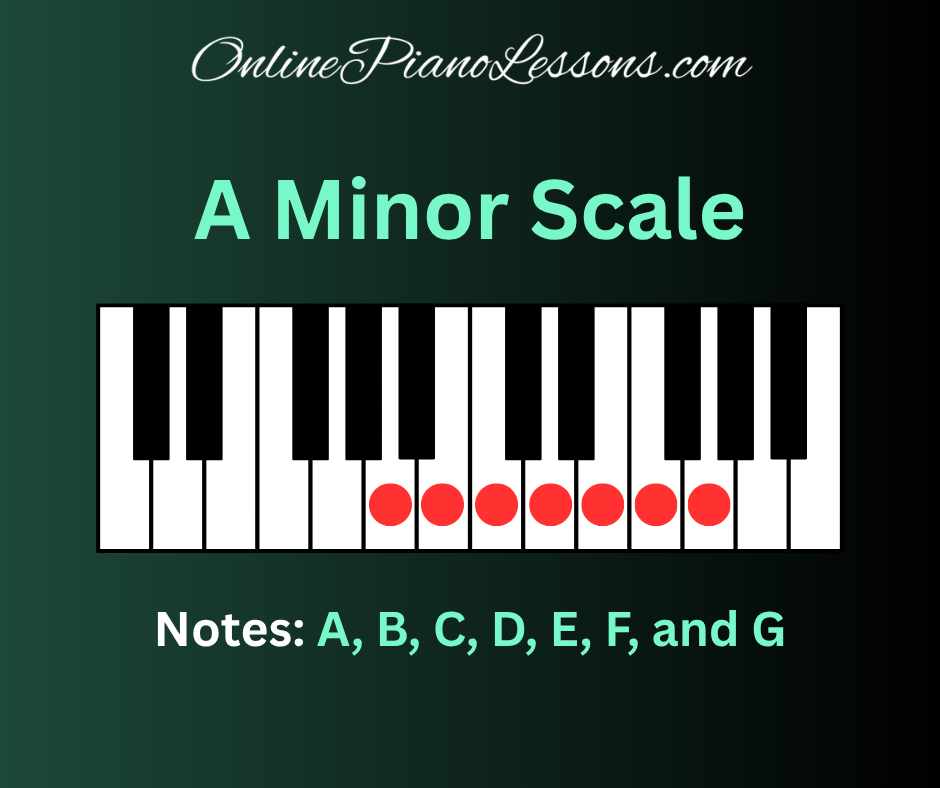
In this post, I’ll discuss the A Minor Scale. I’ll show you what it is, how to find it using the nifty Minor Scale Formula, as well as some other useful tips and tricks to help you along your piano journey.
As the image above shows, the notes in the A minor scale are A, B, C, D, E, F, and G.
Minor Scale Formula
To easily identify and play the A minor scale, you’ll need to use the Minor Scale Formula.
W – H – W – W – H – W – W
Whole step, Half step, Whole step, Whole step, Half step, Whole step, and Whole step
Applying this pattern to the A minor scale, we get the following sequence:
- A to B (whole step)
- B to C (half step)
- C to D (whole step)
- D to E (whole step)
- E to F (half step)
- F to G (whole step)
- G to A (whole step)
This pattern gives the A minor scale its distinctive sound and categorizes it as a natural minor scale.
How to Play the A Minor Scale on the Piano
Right Hand
- Start with your thumb on A
- Place your index finger on B
- Place your middle finger on C
- Place your ring finger on D
- Place your pinky on E
- Tuck your thumb under to play F
- Place your index finger on G
- Finish with your middle finger on A
Left Hand
- Start with your pinky on A
- Place your ring finger on B
- Place your middle finger on C
- Place your index finger on D
- Place your thumb on E
- Cross your middle finger over to play F
- Place your index finger on G
- Finish with your thumb on A
Practice Tips for the A Minor Sale
1. Start Slow:
– Begin practicing the A minor scale at a slow tempo. Focus on playing each note clearly and accurately.
2. Use a Metronome:
– A metronome can help you maintain a consistent tempo as you practice. Start with a slow speed and gradually increase as you become more comfortable.
3. Hands Separately:
– Practice playing the A minor scale with each hand separately before trying to play with both hands together.
4. Finger Positioning:
– Pay close attention to your finger positioning. Proper technique will help you play more efficiently and avoid strain.
5. Increase Speed Gradually:
– Once you’re comfortable playing the scale slowly, start increasing the speed. Focus on maintaining accuracy as you play faster.
The Importance of the A Minor Scale
The A minor scale is not just a practice exercise; it’s a foundational element in music. Here are a few reasons why learning the A minor scale is important:
1. Develops Finger Strength and Dexterity:
– Practicing the A minor scale helps build finger strength and dexterity, which are essential for playing more complex pieces.
2. Improves Muscle Memory:
– Repeated practice of the A minor scale helps develop muscle memory, making it easier to play accurately without looking at the keys.
3. Enhances Understanding of Music Theory:
– Learning the A minor scale deepens your understanding of music theory, including key signatures and chord progressions.
4. Foundation for Improvisation and Composition:
– The A minor scale provides a foundation for improvisation and composition. Many melodies and harmonies are based on minor scales.
Common Chords in A Minor
Understanding the chords in the key of A minor is another crucial aspect of mastering this scale. Here are the primary chords you’ll encounter:
- A Minor (i): – A, C, E
- B Diminished (ii°): – B, D, F
- C Major (III): – C, E, G
- D Minor (iv): – D, F, A
- E Minor (v): – E, G, B
- F Major (VI): – F, A, C
- G Major (VII): – G, B, D
Conclusion: A Minor Scale
Mastering the A minor scale is an essential milestone for any pianist.
By understanding its structure, practicing diligently, and applying it in various musical contexts, you’ll find that the A minor scale opens up a world of musical possibilities.
Whether you’re playing classical pieces, composing your own music, or improvising, the A minor scale is a tool that will serve you well throughout your musical journey.
So, sit down at your piano, practice the A minor scale, and enjoy the beautiful music you can create.
By following this complete guide, you’ll not only gain proficiency in playing the A minor scale but also develop a deeper appreciation for its role in music. Happy practicing!



 I love playing piano, creating new melodies and songs, and further developing my online piano course and making updates/additions to my site OnlinePianoLessons.com!
I love playing piano, creating new melodies and songs, and further developing my online piano course and making updates/additions to my site OnlinePianoLessons.com!  Now that is what I call fun!
Now that is what I call fun!